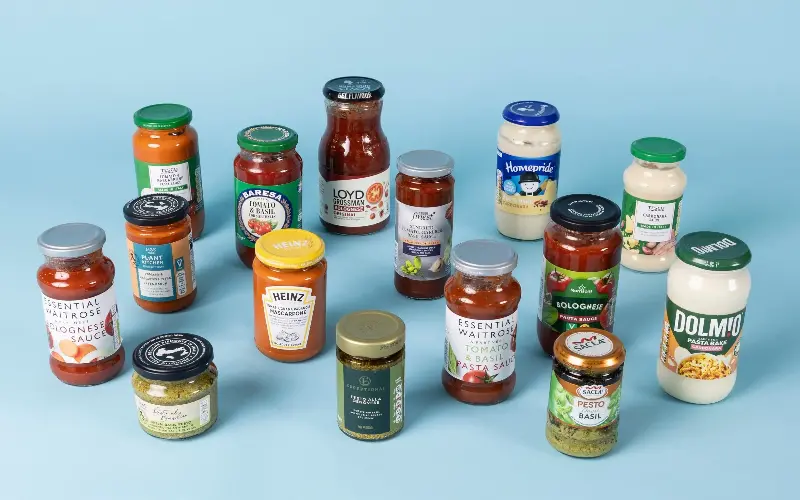
They’re tasty, inexpensive and convenient, so it will come as no surprise that over six million of us use a bottled pasta sauce to make dinner at least once a week – me included. What may come as more of a shock is the fact that a serving of Dolmio’s best-selling bolognese sauce contains 5.5g of sugar, more than a chocolate digestive. But, to be fair to Dolmio, this is not unusual.
Indeed, bottled pasta sauces have come under fire for their high levels of fat, sugar and salt, although some manufacturers have made efforts to improve their formulations in recent years. So, I’ve cast my nutritionist’s eye over the bestsellers to see how far they’ve come.
The assessment process
I included all the top brands and supermarket-own versions, comparing calories, saturated fat, sugar and salt per 100g. The traffic light scores are based on the Food Standards Agency’s traffic light system. Then I examined the ingredients list for any UPF nasties, and finally I considered value for money because healthy and cheap is the holy grail.
To be clear, as this is a health check, I did not taste all of them, but I did consider the online customer reviews when making a recommendation. Note, this test did not encompass fresh sauces in tubs or the more concentrated stir-in sauces, except for pesto.
Pesto
I didn’t think it would be that hard to find a decent pesto containing, as it should, just basil, garlic, pine nuts, Parmesan cheese, extra virgin olive oil and salt. Well, was I wrong! Extra virgin olive oil was very thin on the ground, as were pine nuts, with vegetable/seed oils and cashews the bogus stand-ins.
The cheaper pestos also tend to be bulked out with vegetable fibres or potato flakes/starch, which are not inherently unhealthy, but they are considered UPF additives and you certainly wouldn’t be putting them in a homemade pesto.
Healthiest
M&S Pesto Al Basilico
Taking a very deserved top spot is M&S with this excellent value, and 100 per cent olive oil, UPF-free, authentic basil pesto. As pesto contains oil and cheese, it’s never going to be low in calories or fat, so from a health perspective, we are looking for quality ingredients, and this delivers.
Middle of the road
Asda Extra Special Pesto Alla Genovese
Another 100 per cent olive oil pesto and, although higher in calories and saturated fat than the M&S one, it’s lower in sugar and salt. The ingredients include the thickener pea fibre, not a health deal breaker but to my mind it doesn’t belong in a pesto. So nearly there.
Least healthy
Sacla
This is probably the one you reach for on the shelf, being the UK’s number-one seller, but given the higher price tag, I was expecting better. It has more calories, sugar and salt than the other two pestos.
The primary oil used here is sunflower oil which, although healthy, lacks the heart-healthy monounsaturated fats and cancer-protective antioxidants found in olive oil. It also contains unspecified “natural flavourings” and potato flakes, which nudge it into UPF territory.
Classic tomato
This was undoubtedly the hardest category to judge as a tomato sauce is naturally low in saturated fat, all of those tested were in the “amber” range for salt and most were UPF-free or at worst contained a little thickening agent.
The good news is that your preferred sauce is probably fine, but they did range significantly in price, so my approach here was health on a budget.
Healthiest
Lidl Baresa Tomato & Basil Sauce
You won’t find better value for money, and this classic sauce is made with just tomatoes, basil, onion, garlic and herbs. There is a little sugar too, but if I’m making tomato sauce at home, I’ll usually add a teaspoon or so to mine to counter the acidity of the tomatoes. This is a fabulous bargain buy.
Middle of the road
Waitrose Essential Tomato & Basil Pasta Sauce
This sauce was the lowest in calories and performed very well in terms of saturated fat, sugar and salt. It contains wheat fibre, which is usually added to processed foods to improve texture. While I’m not a fan of additives in general, some additional fibre is no bad thing. However, it does mean it’s not suitable for coeliacs or those with a wheat allergy.
Least healthy
Tesco’s Finest Sun Dried Tomato Garlic & Basil Sauce
It seems rather churlish to say this is the least healthy, as it’s not too bad and it is UPF-free, so I would certainly eat it. However, it was the highest in calories and sugar of the tomato sauces (8g is over two teaspoons), and it’s not especially cheap. There are better options out there.
Tomato and mascarpone
I was expecting more ultra-processed offerings in this sauce category, as creamy products often rely on emulsifiers; however, I was pleasantly surprised to find plenty of UPF-free options. They do tend to be higher in calories, of course, compared to classic tomato sauces.
Healthiest
Heinz Tomato Grana Padano & Mascarpone Pasta Sauce
Step up to the podium, Heinz pasta sauces. If you haven’t discovered this excellent value range yet, then you’re missing out. All are UPF-free, perform well on the traffic light stats and they’re delicious to boot.
This one contains extra virgin olive oil (the best oil for your health) and no added sugars. It also has a Great Taste Award, an independent accreditation scheme that signposts consumers to great-tasting products.
Middle of the road
Tesco Tomato and Mascarpone Sauce
You will not find a better value pasta sauce than this, and the ingredient list is pleasingly short, with just one UPF ingredient: xanthan gum, used as a thickener. Whilst completely safe to consume in the amounts here, excessive consumption may cause digestive problems.
Least healthy
M&S Plant Kitchen Tomato & Mascarpone Style Pasta Sauce
The word “style” in the name should have alerted me to the fact that this doesn’t actually contain any mascarpone, but I did feel a little tricked. Instead of mascarpone, they use a “coconut-based preparation” – water, coconut and sunflower oil, and a long list of additives.
This was the most expensive product tested and while it had some pros, including being relatively low in saturated fat and sugar, it was packed with UPF ingredients. This is a common issue with many plant-based alternative products, so it’s essential to check the ingredient list.
Bolognese
As I’m not a regular purchaser of bolognese sauces, I was surprised to find that they don’t contain meat; you are expected to add your own, which in my mind slightly defeats the point of a pre-made sauce. Nevertheless, there are some decent options out there, and as long as you have time to fry up some mince, you’re in business.
Healthiest
Waitrose Essential Bolognese Sauce
What a find! UPF-free, with authentic ingredients including olive oil (no other oils) and red wine, this sauce came up trumps on saturated fat and sugar, and was the lowest in salt and calories. Amazing value for money.
Middle of the road
Loyd Grossman Bolognese Pasta Sauce
A popular and tasty sauce, this is not a bad choice as it is UPF-free; however, it isn’t entirely olive oil (sunflower oil is also used) and it is considerably higher in sugar than the Waitrose sauce. It’s also more expensive.
Least healthy
Morrisons Bolognese Sauce
Honestly, it was a toss-up here because, nutritionally, this isn’t a million miles from the Loyd Grossman sauce and it is significantly cheaper, which probably explains why it has only sunflower oil and no olive oil.
Modified maize starch, a UPF additive, also pops up on the ingredients list. With a 3.2 customer rating, it probably won’t wow the taste buds either.
Carbonara
Perhaps it’s the cook in me, but I feel there’s something intrinsically wrong with a bottled carbonara pasta sauce. They have an off-putting whiff and the bacon or guanciale often paired with it is another worry; processed meat is never going to be something a nutritionist recommends because of its links with colorectal cancer. With these reservations in mind, I offer the following suggestions.
Healthiest
Homepride Carbonara Pasta Bake
All the bottled carbonara sauces I found were ultra-processed, and this was no exception, with a list of ingredients as long as your arm. Setting this aside, this sauce was the lowest in calories and saturated fat and was well within the green zone for sugar and salt.
It’s certainly cheaper to use this than make a carbonara from scratch, but not much easier, so I think I’ll be sticking to homemade.
Middle of the road
Tesco Carbonara Sauce
Again, this product contains UPF ingredients, but it offers excellent value for money and is exceptionally low in sugar. The customer reviews on Tesco’s website are positive, with a 4.5 rating, so it’s probably tasty enough. Although, and this applies to all the sauces here, it’s a long way from an authentic carbonara.
Least healthy
Dolmio Carbonara Pasta Bake
This sauce boasts that it is made with real cream, which is probably not a draw for purists – carbonara is famously cream-free. Unfortunately, it’s also made with a lot of ultra-processed ingredients, such as stabilisers and emulsifiers, and has more sugar than my other picks.
How to make your pasta bowl more nutritious
Choose a wholewheat pasta
100g of regular spaghetti contains 1.5g of fibre, while wholewheat spaghetti has 5.3g (guidelines recommend having 30g of fibre per day).
Stick with a classic tomato sauce
These were by far the best bets among the bottled sauces, mainly UPF-free, affordable and healthy.
Use extra-virgin olive oil
Drizzle with extra-virgin olive oil for added health benefits from the good fats and anti-inflammatory plant compounds.
Add some lean protein
Time-saving options are pre-cooked chicken, tinned sardines or cooked prawns.
Add more veggies
Wilt in some spinach leaves, add a couple of handfuls of frozen peas, sweetcorn or even better, mixed veg – you’ll be upping your plant foods with minimal effort. It’s recommended to eat 30 different plant foods a week for good gut health.
